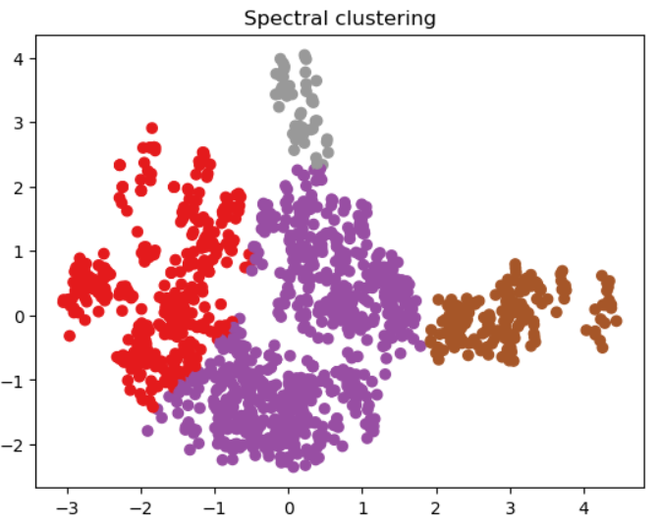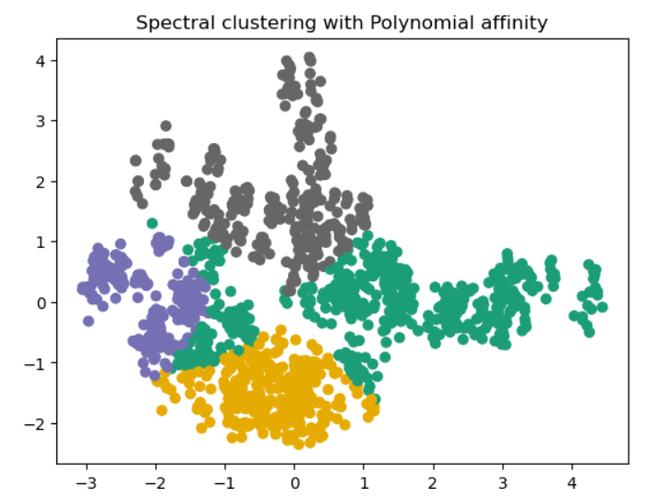
|
|
Clustering plays a crucial role in unsupervised machine learning by grouping data points into clusters based on their similarities. This technique helps us uncover hidden structures and patterns within the data. Spectral clustering, an approach that utilizes properties of graphs and linear algebra, is commonly employed for this purpose. Unlike algorithms like K-Means, spectral clustering is particularly effective in dealing with complex and non-convex data structures. It allows us to explore relationships among data points and has proven valuable in fields such as image segmentation, social network analysis, and community detection. What is Spectral Clustering?Spectral Clustering is a technique, in machine learning that groups or clusters data points together into categories. It’s a method that utilizes the characteristics of a data affinity matrix to identify patterns within the data. Spectral clustering has gained popularity across fields, including image segmentation, social network analysis, and community detection.
How does Spectral Clustering work?
where W is the graph’s adjacency matrix, a square matrix that contains the similarity between each pair of nodes, and D is the graph’s degree matrix, a diagonal matrix that contains the number of edges associated to each node.
Key Concept of Spectral ClusteringSpectral clustering is fundamentally grounded in spectral graph theory, which serves as the underpinning for comprehending its operational mechanism. Spectral graph theory treats data points as nodes within a graph, where the connections or edges linking these nodes depict pairwise similarity or affinity. The central concept is to leverage the eigenvalues and eigenvectors of a matrix derived from this graph to identify clusters. The Laplacian matrix, a pivotal matrix in spectral clustering, encapsulates the interrelations between data points within a graph structure. Through the calculation of eigenvalues and eigenvectors of this matrix, spectral clustering efficiently divides the data into clusters by exploiting the spectral characteristics inherent in the graph.
where U is a matrix of eigenvectors, and Lambda is a diagonal matrix of eigenvalues.
Implementation of Spectral ClusteringImporting necessary LibrariesPython3
To manipulate data, visualize it, cluster data, do preprocessing, reduce dimensionality, and assess performance, the code imports libraries. After standardizing or normalizing the data, it carries out spectral clustering and uses silhouette scoring to evaluate the clustering outcomes. Loading DatasetPython3
Output: variance skewness curtosis entropy class The program reads the ‘BankNoteAuthentication.csv’ CSV file into the ‘raw_df’ pandas DataFrame. A preview of the data structure and content is shown in the first few rows of the DataFrame using the ‘head()’ method. Scaling DataPython3
The code uses StandardScaler from sklearn.preprocessing to standardize the data. After generating a StandardScaler object, it fits the raw data (raw_df) to provide a scaled version of the raw data (X_scaled). In order to preserve the data structure and enable additional analysis, the scaled data is then transformed into a pandas DataFrame (X_scaled). Implementing PCAPython3
Output: P1 P2 The code uses PCA from sklearn.decomposition to reduce dimensionality. It fits the scaled data (X_scaled) to a PCA object with two principle components (n_components=2) and converts the scaled data into a reduced-dimensionality representation (X_principal). The modified data is subsequently assigned column names (‘P1’ and ‘P2’) and processed into a pandas DataFrame (X_principal). In order to give a brief summary of the reduced data, the method ends by displaying the first few rows of the modified DataFrame (X_principal.head()). Building and Training the ModelPython3
The code uses SpectralClustering from sklearn.cluster to build a spectral clustering model. It uses the radial basis function (RBF) as the affinity measure (‘affinity=’rbf’) and specifies the number of clusters to identify (n_clusters=4). The predicted cluster labels are then saved in the ‘labels’ variable once the model has been fitted to the reduced-dimensionality data (X_principal). Visualizing the Spectral ClusterPython3
Output:  Spectral Clustering The clustering results are visualized using matplotlib.pyplot by the code. With the reduced-dimensionality data (X_principal), it generates a two-dimensional scatter plot (P1 and P2). The spectral clustering model’s predicted cluster labels are represented by the colors of the data points. The plot is called “Spectral clustering” and plt.show() is used to display it. Visualizing the Spectral Cluster using different AffinityPython3
Output:
Advantages of Spectral clustering
Disadvantages of Spectral ClusteringWhile spectral clustering offers many advantages, it also has some limitations:
ConclusionIn summary, Spectral Clustering is a versatile and valuable machine learning technique that harnesses the principles of graph-based and spectral graph theory to unveil meaningful clusters within datasets. Its popularity has surged due to its competence in handling intricate data structures and uncovering concealed patterns. Spectral Clustering offers numerous advantages, such as its ability to work with non-convex clusters, reveal hidden structures, and maintain resilience against noise. It finds applications in diverse fields like image processing, social network analysis, and community detection. However, it’s crucial to acknowledge its limitations, including sensitivity to hyperparameters, computational complexity, and challenges with scalability when dealing with very large datasets. Spectral Clustering enriches the clustering toolkit, providing an effective way to unravel intricate data relationships. Its performance relies on proper parameter tuning and a firm grasp of the underlying graph theory concepts. When applied judiciously, Spectral Clustering can serve as a potent tool for unearthing concealed structures and patterns within a variety of real-world datasets. |
Reffered: https://www.geeksforgeeks.org
| AI ML DS |
Type: | Geek |
Category: | Coding |
Sub Category: | Tutorial |
Uploaded by: | Admin |
Views: | 9 |
